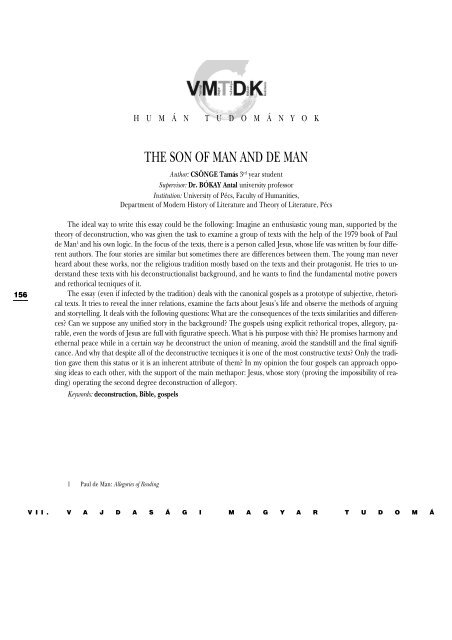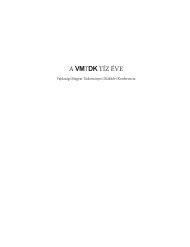Rezümékötet 2008. - vmtdk
Rezümékötet 2008. - vmtdk
Rezümékötet 2008. - vmtdk
Create successful ePaper yourself
Turn your PDF publications into a flip-book with our unique Google optimized e-Paper software.
156<br />
THE SON OF MAN AND DE MAN<br />
Author: CSÖNGE Tamás 3 rd year student<br />
Supervisor: Dr. BÓKAY Antal university professor<br />
Institution: University of Pécs, Faculty of Humanities,<br />
Department of Modern History of Literature and Theory of Literature, Pécs<br />
The ideal way to write this essay could be the following: Imagine an enthusiastic young man, supported by the<br />
theory of deconstruction, who was given the task to examine a group of texts with the help of the 1979 book of Paul<br />
de Man 1 and his own logic. In the focus of the texts, there is a person called Jesus, whose life was written by four different<br />
authors. The four stories are similar but sometimes there are differences between them. The young man never<br />
heard about these works, nor the religious tradition mostly based on the texts and their protagonist. He tries to understand<br />
these texts with his deconstructionalist background, and he wants to find the fundamental motive powers<br />
and rethorical tecniques of it.<br />
The essay (even if infected by the tradition) deals with the canonical gospels as a prototype of subjective, rhetorical<br />
texts. It tries to reveal the inner relations, examine the facts about Jesus’s life and observe the methods of arguing<br />
and storytelling. It deals with the following questions: What are the consequences of the texts similarities and differences?<br />
Can we suppose any unified story in the background? The gospels using explicit rethorical tropes, allegory, parable,<br />
even the words of Jesus are full with figurative speech. What is his purpose with this? He promises harmony and<br />
ethernal peace while in a certain way he deconstruct the union of meaning, avoid the standstill and the final significance.<br />
And why that despite all of the deconstructive tecniques it is one of the most constructive texts? Only the tradition<br />
gave them this status or it is an inherent attribute of them? In my opinion the four gospels can approach opposing<br />
ideas to each other, with the support of the main methapor: Jesus, whose story (proving the impossibility of reading)<br />
operating the second degree deconstruction of allegory.<br />
Keywords: deconstruction, Bible, gospels<br />
1 Paul de Man: Allegories of Reading<br />
H U M Á N T U D O M Á N Y O K<br />
V I I . V A J D A S Á G I M A G Y A R T U D O M Á




